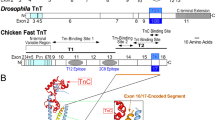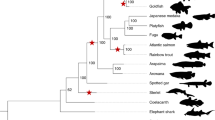Abstract.
Prosaposin is a multifunctional protein encoded by a single-copy gene. It contains four saposin domains (A, B, C, and D) occurring as tandem repeats connected by linker sequences. Because the saposin domains are similar to one another, it is deduced that they were created by sequential duplications of an ancestral domain. There are two types of evolutionary scenarios that may explain the creation of the four-domain gene: (1) two rounds of tandem internal gene duplication and (2) three rounds of duplications. An evolutionary and phylogenetic analysis of saposin DNA and amino acid sequences from human, mouse, rat, chicken, and zebrafish indicates that the first evolutionary scenario is the most likely. Accordingly, an ancestral saposin-unit duplication produced a two-domain gene, which, subsequently, underwent a second complete tandem duplication to give rise to the present four-domain structure of the prosaposin gene.
Similar content being viewed by others
Author information
Authors and Affiliations
Additional information
Received: 8 February 2001 / Accepted: 29 June 2001
Rights and permissions
About this article
Cite this article
Hazkani-Covo, E., Altman, N., Horowitz, M. et al. The Evolutionary History of Prosaposin: Two Successive Tandem-Duplication Events Gave Rise to the Four Saposin Domains in Vertebrates. J Mol Evol 54, 30–34 (2002). https://doi.org/10.1007/s00239-001-0014-0
Issue Date:
DOI: https://doi.org/10.1007/s00239-001-0014-0




